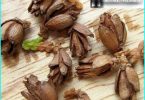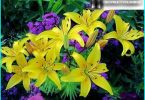The contents
The bleeding heart – the name of the infrequent, more often we hear a more shaped version «broken heart». Such capacious name flower got due to a curious form of flower buds, which resemble small hearts. Some know this plant as dusparic – literal translation of the words dis and kentron – «twice» and «spur». From the rich legends of the French flower got the name «heart Jeanette», in practical Germans – «flower heart», at creative English «the lady in the tub», well, Russian people dubbed him the favorite in a minor way «a broken heart».
Although many consider this plant to the European, he was born in Japan, where in Europe it was imported only in 1816. Beautiful flower immediately attracted the attention of bright colours and interesting shape of the buds, so I’ve become a frequenter of gardens, aristocrats and nobles. Custom, fine the bleeding heart gardeners loved so much that even the names of the varieties turned out «speaking»: exquisite, beautiful, splendid, excellent, exceptional.
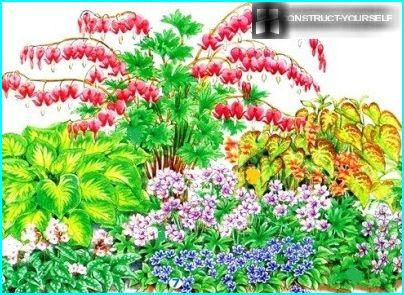
Place the plants in the flower bed or flower garden choose, depending on its grade. High gorgeous dicentra looks great in the center of the composition, miniature broderna or exclusive — on the edges or along the curb
Soil preparation for planting of flower
Although the plant is not capricious, for the best flowering from autumn to prepare the place for planting and to cultivate the soil. The bleeding heart thrives in areas lit by the sun and in the shade of the trees, so with the device of a flower bed problems should arise. On the shaded site buds and bloom a little later.
Fall must be carefully selected to dig for planting a flower bed to a depth of 40 cm and make it more fertile by adding compost (about 3 lbs. per m?). For mineral makeup suitable fertiliser for garden flowers in the amount of 15-20 g per 10 liters of water. In the future when the plant will give color, should be another 3-4 times to feed that ensures rapid growth and profuse flowering. After rain or watering the soil around the bushes should be loosened, but with great care because the roots of the plants are close to the surface.
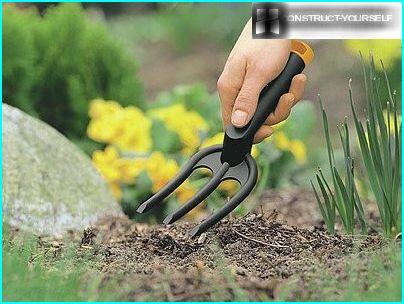
For weeding and loosening the soil is best to use a tool like a small fork — treatment of the soil will turn gentle and fragile roots will not be damaged
The soil should be relatively light and well affliction moisture and air. If the soil is heavy clay, you need to dilute it with river sand or peat in order to avoid rotting of the roots. Many gardeners do in the winter «pie» of dry straw, or reeds, laying them in layers and alternating with the ground in specially dug pit.
The best methods of reproduction and transplantation
There are three ways of reproduction dicentra – dividing rhizomes, aerial shoots and seeds. The last path immediately dismissing – the plant usually forms a small amount of seed, but some varieties (e.g., «Gorgeous») in temperate latitudes generally do not give them. Cultivation of seeds was also problematic, so the best method of propagation – separating time of parts of roots or shoots.
To divide the plant is best in late summer when aboveground shoots die off. The roots break very carefully removed from soil and dried – in a slightly lethargic state, they become more elastic and less broken. Then carefully divide the rhizomes into pieces so that each piece of left 3-4 buds to form shoots. Pieces of root buried in the ground for a dimly lit area and abundantly watered with warm water. To protect the slices can be sprinkled with ashes. When delenki rooted, they can be transplanted to the flowerbed.
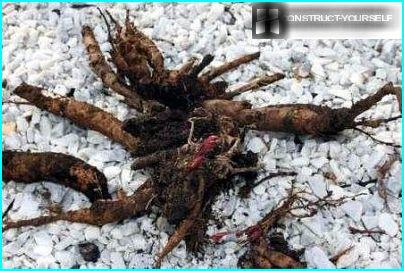
For the division of the old Bush part of the plant is not suitable, you need to dig up the whole plant. The rhizome is carefully to analyze the elements by removing loose fragments and thin appendages
Early spring is also suitable for transplant direntry. You must choose the moment when the shoots are still «sleep» or just started to grow. The division is better done once in 5-6 years, but not less, as the roots begin to grow old and wither away.
The procedure for planting is the following:
- on the flowerbed to dig small holes, spaced 30-40 cm (the larger the Mature plant, the longer the distance);
- in each hole put 3-4 delenki – for splendor;
- fill the holes with earth, lightly compacted;
- to water heated by the sun water.
Breeding ground by cuttings carried out in the spring. Gently rake the soil at the base of the Bush and cut with a sharp knife a small part of the plant with «promenade». Then about a day kept the cuttings in stimulant for the roots and planted in well watered soil, finally covering greenhouse tightly with foil. About a month later there will be roots. On a constant flowering sprouts planted only a year.
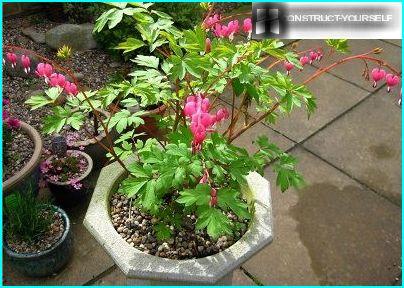
If it is important to show the beauty and originality of the plant necessary to make it a single landing in a flower pot planter or a large ceramic pot
Particularly care for this plant
Proper cultivation dicentra is in permanent care, during which monitor the lighting, timely irrigation, weeding and hoeing.
The plant blooms equally well in the shade and in the sun, but the pomp and the timing of its flowering is directly dependent on the degree of illumination. In the open territory of the buds bloom and wither early, and the stalks are not very magnitude and luxuriance. Shaded areas on a color typed slower, but «hearts» are bright, large and not disappear until mid-summer.
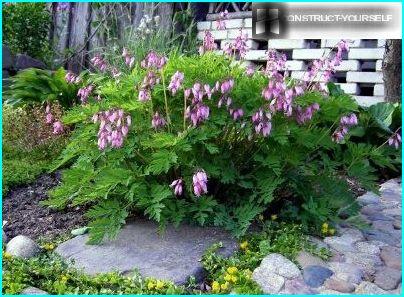
The bleeding heart just loves sandy and rocky soil. therefore, one of the best places of its location — gentle slopes along paths lined with stone or brick
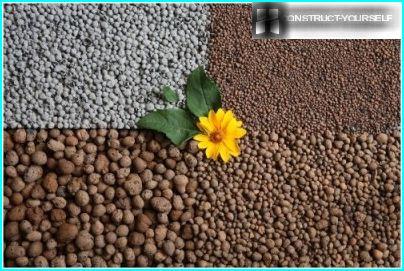
For the device the drainage layer located under the topsoil layer, suitable expanded clay fines, and gravel or coarse river sand
Some tips care dicentral:
- The rich color of the buds off in the spring to feed the roots of superphosphate, and then in the process of growth to make 3-4 feeding.
- Even after the plant will wither, it is necessary to make fertilizer with nitrogen content for the best possible formation of new buds.
- During strong temperature reduction better plant cover using non-woven material.
- The faded brush need to be removed in time, then the duration of flowering of the other branches will last.
- With the advent of autumn and remove the aboveground part, leaving stumps no higher than 5 cm.
Requires special attention to the soil. In waterlogged roots dicentra start to rot, therefore, to accommodate the flower beds is better to choose elevated places. If the plant is already planted and the soil is regularly flooded, it artificially raised the ground and equip the flower bed drainage layer and grooves to drain the water. At high temperature, irrigation should spend more and more abundant, the roots do not dry out. To delay moisture and overheating protection use peat or humus, which is spread a thick layer around the base of the plant.
The most common varieties dicentra
The gorgeous bleeding got its name because of its size is the largest and most lush plants. Adult specimen looks like body covered with Lacy foliage and densely covered with blooming brush Bush. The most common tint gamma – bright pink, a much less common plant with white flowers. White forms have lower growth rates, but no less lush and decorative.
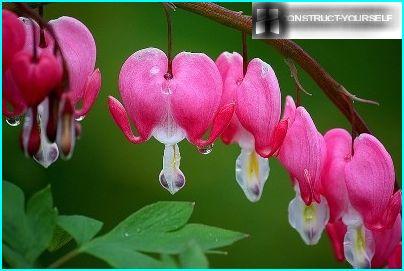
To the bleeding heart is gorgeous again flourished towards the end of summer, you need to use a small trick: after flowering brush with stems neatly cut
The bleeding heart is beautiful – a miniature shrub, reaching a maximum height of 30 cm. Blooms are small but delicate flowers from pale white to bright purple color. The flowering period is large enough – from early spring to late summer. Some varieties have an unusual silvery color of the leaves, as if covered with a light fuzz. The plant is suitable for decorating borders and Alpine gardens.
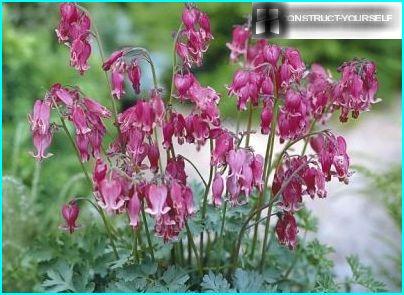
The bleeding heart is beautiful – one of the plants that manages to give seeds. This is due to its long flowering, until the autumn, when there is full formation of bolls with seeds
Ditsentra exceptional (superior) is a small growth – not more than 25 cm On the background of bluish-grey leaves, resembling the leaves of a fern adorn the fragile pink, purple or white blossoms. Blooms modestly, not very profusely for 2 months, and cool in summer, throughout the season. This plant is easy to winter forcing.
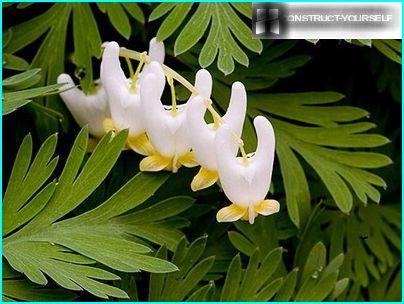
Due to the similarity of leaves with fern, bleeding heart exclusive is perfect for bold decorating the Alpine hills, rockeries or low pine plantations
The result of breeding and selection became the bleeding heart twining (climbing) – amazing variety, an annual, native to which is considered to be the Himalayas. It has the appearance, not the usual Bush, and quite long, up to 2 m vines, which blooms beautiful yellow buds.
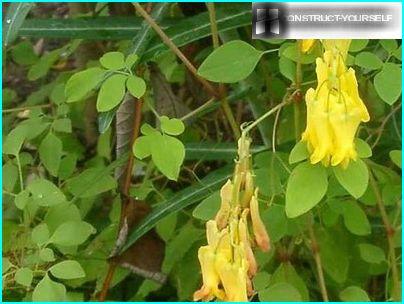
To grow curly the bleeding heart is harder than her relatives. Vines require special care and attention, higher temperatures and absolutely can’t stand the cold
Brodyazhnaya bleeding heart is small in size – no more than 15-20 cm and short roots. Flowers are rare, but large, have white, pink and red colour. Has a later flowering period from July to September. Grows well in a temperate climate, easy to tolerate cold.
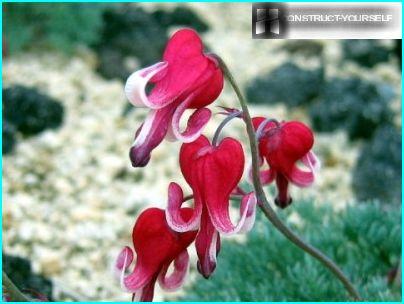
Brodyazhnaya bleeding heart prefers a not too wet soil. Likes sandy, gravelly or rocky ground, so it must be used for decorating rock gardens, screes and slopes
The bleeding heart is a universal flower, equally suitable for single landings, and decorating a group of flower beds. Low grades are used to decorate lawns, Alpine gardens, rockeries and thickets of evergreen shrubs, large – to create a lush layered flower beds around the house.


